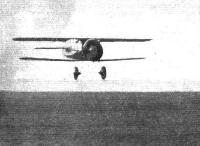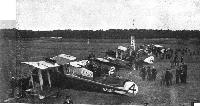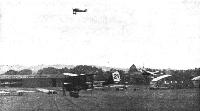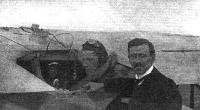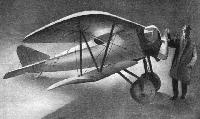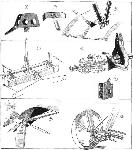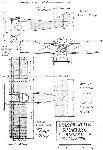
Описание
Страна: Великобритания
Год: 1919
Журнал Flight
Flight, April 10, 1919.
AN INTERESTING GRAHAME-WHITE SPORTING MODEL
WITH the coming of peace there will undoubtedly be a great demand for aeroplanes for a variety of peace time purposes. The large twin- or multi-engined machine for the carrying of mails and passengers, seaplanes of various types for work over the sea and for short pleasure cruises around our coast towns, racing machines for use in speed competitions, touring machines for the private owner, and so one could go on enumerating the various fields that will have to be catered for by the aeroplane constructor. The machine described in the following notes is designed, as the title indicates, for sporting purposes, but is not, we may point out, a racing machine in the ordinary sense of the term, although it might very well be used for a race around the pylons at Hendon as of old, should those merry old times come back again.
The feature which impresses one most on first seeing this Grahame-White model, to which the name of the "Bantam" has been given, is its extremely small size. As a matter of fact, the G.W. "Bantam" is, we think, the smallest biplane we have seen, with the exception of the diminutive Piggott biplane built for the Military Trials of 1912. The span of the G.W. "Bantam" is only 20 ft. and its overall length 16 ft. 6 ins., so that it may be housed in a very small shed. The smallness of the machine will, perhaps, be more evident from an examination of one of the accompanying illustrations than it would be possible to convey by any quotation of figures. The man shown standing in front is drawn to correct proportions and shows the compactness of the machine.
As already mentioned, the G.W. "Bantam" is not a racing machine, the wing section having been designed with a view to fairly high lift rather than for high speed. In spite of this fact, however, the maximum speed is quite good - about 102 m.p.h. at low altitudes and 93 m.p.h. at 10,000 ft. As the engine fitted is of 80 h.p. (le Rhone), this is not a bad performance, especially as the climb appears to be very good. The landing speed is about 40 m.p.h.
When we saw the machine in flight last week at Hendon, she was piloted by Capt. Chamberlain, who did a series of spins on her and also a loop. This was, we understand, the first time that this machine had been looped, and she did it without a hitch. As regards her handling in the air, she appears capable of practically all t he evolutions performed by the higher-powered machines, although her lower power naturally does not allow of such steep climbs or prolonged "Zooms" as may be tackled with immunity in single-seaters designed for military purposes and fitted with engines of three or four times her power. So far as we were able to judge the machine is very sensitive on the controls, both laterally and longitudinally. Tins is, presumably, due to her small moments of inertia around all three axes, and to t he general compactness of the machine. The present model is an experimental one, and if during the very exhaustive trials now being conducted daily by Capt. Chamberlain it is found that the machine is a little too sensitive, this matter can probably be altered by fitting smaller ailerons and elevators. It is probable, however, that the majority of ex-service pilots who will purchase such a machine will consider this sensitiveness an advantage rather than otherwise, and will prefer an ample amount of control.
Constructionally the G.W. sporting model shows many detail features that are of interest, some of which we have illustrated in the accompanying sketches. The object which the designer, M. E. Boudot, has kept in mind in getting out the details is simplicity and ease of manufacture. The construction of the wings follows more or less standard practice as regards the details. The spars, which are of I-section spruce, rest in mild steel boxes to which are attached the lugs for the interplane struts, and also the wiring plates and sockets for the compression tubes of the internal bracing system. In the accompanying set of sketches Fig. 1 shows one of the top plane front strut attachments. The spar box has riveted and brazed to it the lug for the interplane strut, and is extended inwards to form the wiring plate for the front lift cable. Two vertical bolts secure the box to the spar, while the wiring plate for t he internal drift bracing is attached to the spar and to the box by two horizontal bolts. (Fig. 2.) A somewhat unusual feature of the top plane is the position of the rear spar, which is a good deal farther forward than is the custom. This is done in order to make it clear the pilot where it crosses the fuselage.
The top plane runs straight across from tip to tip without any dihedral, and is attached to the top of the fuselage by a very strong box-like structure, covered in with the rest of the body and containing the main petrol tank. The rear face of this box serves as a support for the instrument board. The petrol service tank is enclosed in the centre of the top plane.
The bottom plane is built in two halves, each attached to the ends of two short lengths of spars permanently fitted under the bottom of the fuselage. The front spar attachment is situated between the front and rear chassis struts, while the rear spar attachment coincides with and is part of the rear chassis strut fitting. The bottom plane spar fittings are of the same type as those of the top plane. Fig. 3 shows the bottom front spar fitting in external view. In principle it is the same as that shown in Fig. 1, but the lug has accommodation for two interplane struts, the struts being arranged in this machine in the form of a letter N. The struts are elliptical section steel tubes. This same N formation is also found in the lift bracing, which consists of plain stranded cable. In addition to the usual two lift cables there is a third one running from the top of the rear interplane strut to the attachment of the bottom front spar to the fuselage. The obliquity of this third cable assists in relieving the internal drift bracing of some of its load. The landing cables run from the bases of the interplane struts to a single point at the top rear spar where this meets the top of the fuselage.
The fuselage is of the usual girder type, with longerons of rectangular section solid ash. The struts are vertical in the rear portion of the body, and the bracing here is of solid wire. In the front part, that is from the pilot's seat forward, the body struts are arranged as a series of triangles without any wire bracing. The bottom of the fuselage is flat, but the top is surmounted by a turtle back, and the sides are slightly rounded off aft and more markedly so in front, where they finally merge into the circular shape of the cowl. The sides are rounded off with longitudinal stringers, which are attached direct to the vertical body struts in the rear portion, while in front, where the curvature is more pronounced, they are secured to light three-ply formers. The covering of the body is fabric in the rear half and three-ply wood in front.
The controls are of a very neat type, and are illustrated in some of the accompanying sketches. The details of the universal joint of the control stick are somewhat unusual and form the subject of a sketch. On the dash in front of the pilot are mounted a very complete set of instruments, conveniently arranged. The engine plate is one of the lightest we have yet seen, weighing as it does only 12 lbs. It consists of the usual capping plate over the nose of the fuselage, made of 14 gauge steel and further lightened by circular holes, flanged to give greater rigidity. The rear engine-bearer is formed by a pyramid of channel section members bolted to the main engine plate and carrying at their other end - at the apex of the pyramid - the rear engine support. The engine - an 80 h.p. le Rhone - is overhung and is surrounded by an aluminium cowl. At present no "spinner" is fitted, but later it is intended to fit one over the hub of the airscrew. The latter has, we understand, been designed according to data furnished by M. L. de Bazillac, who has devised a method which affords, by the simple use of a series of charts, the simultaneous solution of both aerodynamical and static propeller problems at a glance without any involved calculations, all such data as diameter, pitch angle, blade sections, intake velocity, etc., being read off directly on the charts. As the machine is so small, it has been desirable to fit a propeller of very small diameter so as to keep down the height of the undercarriage, and this fact formed a severe test of M. de Bazillac's method. However, the efficiency appears to be good in spite of the small diameter allowed, and the method appears to have been proved very satisfactory. Certainly for quickness it has much to recommend it.
The undercarriage is a simple Vee type, with struts of streamline section steel tubes. The manner of attaching these struts to the body is shown in one of the accompanying sketches. A very stout eyebolt passes through the bottom longerons and through a heavy gauge wiring plate, the outer end of which serves as an anchorage for the lift cables, and the inner end of which is attached to a steel tube running horizontally across the bottom of the fuselage. Thus, when the machine is in the air this transverse tube is in tension owing to the pull of the lift cables, while during landing shocks it is put into compression owing to the angularity of the undercarriage front struts. The details will be clear from the sketch. At the bottom the two chassis struts meet on a short longitudinal tube to which the rubber cord is attached. At the point where the struts meet this tube internal reinforcement is provided to afford extra strength. There are two cross tubes in the undercarriage, one in front of the axle and one behind it. These are bolted to the chassis struts, the bolts passing through short lengths of tube welded into the struts, so that the compression caused by tightening up the bolts does not fall on the thin walls of the struts, but on the short lengths of tube welded into them transversely. The whole undercarriage is of the simplest type imaginable, and looks very sturdy for such a little light machine. It is almost superfluous to add that the wheels are of the disc type.
The following brief particulars should be of interest: Weight empty, 640 lbs. Weight fully loaded, 995 lbs. Weight per horse-power, 12.45 lbs. Load per square foot, 7.51 lbs. Tank capacity, 2.3 hours. Speed at low altitudes, 102 m.p.h. Speed at 10,000 ft., 93 m.p.h. Landing speed, 40 m.p.h. Disposable load apart from fuel, 200 lbs.
As regards price, it is at present somewhat difficult to settle on a fixed price, but we understand that the sporting model will probably cost about 500 guineas.
Flight, June 26, 1919.
THE AERIAL DERBY
THE MACHINES
No. 2. - The Grahame-White Bantam, 80 h.p. Le Rhone
Two of these machines started in the race. Except for the colours in which they were painted, the two machines were alike. No. 2 was piloted by Capt. P. R. T. Chamberlayne, while the other machine, No. 5, was flown by Maj. R. H. Carr. The G.W. Bantam was described in FLIGHT recently, when sketches of constructional details were given. It has a top plane of slightly greater dimensions than the bottom one, the two being separated by one pair of interplane struts on each side. These struts are of N formation, as seen in the side elevation. The machine is very small, in fact it was the smallest machine entered for the Aerial Derby as regards size, although not as regards power. It is very sensitive on the longitudinal controls, and gives the impression that it could do with a larger tail plane, or smaller elevators, or possibly both.
No. 5. - The Grahame-White Bantam, 80 h.p. Le Rhone
For this machine, see note dealing with No. 2.
- Журнал Flight
Фотографии
-
Журнал - Flight за 1919 г.
THE G.W. "BANTAM." - Three-quarter rear view.
-
Журнал - Flight за 1919 г.
Front view of the G.W. "Bantam."
-
Журнал - Flight за 1919 г.
Rear View of the G.W. "Bantam."
-
Журнал - Flight за 1919 г.
The G.W. "Bantam" in flight, piloted by Capt. Chamberlain.
-
Jane's All The World Aircraft 1919 /Jane's/
Side view of the Grahame White "Hanymede" (3/270 h.p. Sunbeam Maori Engines); and of the Grahame White "Bantam" (80 h.p. Le Rhone).
Другие самолёты на фотографии: Grahame-White E.IV Ganymede - Великобритания - 1918
-
Журнал - Flight за 1919 г.
THE LONG AND THE SHORT OF IT. - The Grahame-White "Bantam" standing under the wing of the G.W. bomber "Ganymede."
Другие самолёты на фотографии: Grahame-White E.IV Ganymede - Великобритания - 1918
-
Журнал - Flight за 1919 г.
THE CROSS-COUNTRY HANDICAP AT HENDON AERODROME ON WHIT-MONDAY: The five starters lined up for the race, at the other side of the aerodrome
Другие самолёты на фотографии: Avro 504/504A/B/C/J/K - Великобритания - 1913BAT FK-22 / FK-23 Bantam - Великобритания - 1918De Havilland D.H.6 - Великобритания - 1917
-
Журнал - Flight за 1919 г.
THE AERIAL DERBY. - The competitors lined up at the starting line ready for the race.
Другие самолёты на фотографии: Avro 504/504A/B/C/J/K - Великобритания - 1913Bristol M.1A / M.1B / M.1C (Bristol Bullet) - Великобритания - 1916De Havilland D.H.4 - Великобритания - 1916
-
Журнал - Flight за 1919 г.
STARTERS IN HENDON'S AIR RACE ON SATURDAY: Left to right - B.A.T., piloted by Major Draper (winner; Avro, pilot Capt. D. H. Robertson, A.F.C.; Avro, pilot Major R. H. Carr, A.F.C., D.C.M. (second); G.-W. Bantam, pilot Capt. P. R. T. Chamberlayne (third); and Avro, pilot Lieut. G. R. Hicks, D.F.C.
Другие самолёты на фотографии: Avro 504/504A/B/C/J/K - Великобритания - 1913BAT FK-24 Baboon - Великобритания - 1918
-
Журнал - Flight за 1919 г.
RACING AT THE LONDON AERODROME, HENDON: Start on Saturday of the first heat. Capt. Gathergood first away on an Airco, followed by Lieut. Park on an Avro, Capt. Robertson (Avro) and the winner of the final, Capt. Chamberlayne, on a G.W. Bantam.
Другие самолёты на фотографии: Avro 504/504A/B/C/J/K - Великобритания - 1913De Havilland D.H.6 - Великобритания - 1917
-
Журнал - Flight за 1919 г.
RACING AT THE LONDON AERODROME, HENDON: First heat on Saturday as seen from No. 1 Pylon. High up in the air, Capt. Chamberlayne (final winner), below Capt. Gathergood (21), first in the heat, followed by Lieut. Park (4)
Другие самолёты на фотографии: Avro 504/504A/B/C/J/K - Великобритания - 1913De Havilland D.H.6 - Великобритания - 1917
-
P.Lewis - British Racing and Record-breaking Aircraft /Putnam/
The Grahame-White G.W.E. 6 Bantam K-150 / G-EAFK, 80 h.p. le Rhone, which Capt P. R. T. Chamberlayne flew in the 1919 Aerial Derby. A similar machine, No. 5, was piloted by Maj. R. H. Carr.
-
Журнал - Flight за 1919 г.
Capt. Chamberlain, the G.W, pilot of the Grahame-White "Bantam,'' in the cockpit, and standing against the machine, M. #. Boudot, the designer.
-
Журнал - Flight за 1919 г.
A SKETCH OF THE GRAHAME-WHITE "Bantam." - The man standing in front gives a good idea of the small size of this machine.
-
Журнал - Flight за 1919 г.
SOME CONSTRUCTIONAL DETAILS OF THE GRAHAME-WHITE SPORTING MODEL. - 1. The spar box and lug for attachment of interplane strut. 2. The wiring plate and socket for tubular compression strut of internal bracing. 2 is secured to 1 by two horizontal bolts. Fig. 3 is an external view of the attachment to the bottom front spar of the interplane struts. The controls are shown in Fig. 4, details of which are indicated in Fig. 5. Fig. 6 shows the fuselage clip. Details of the undercarriage are shown in Figs. 7 and 8.
-
Журнал - Flight за 1919 г.
THE GRAHAME-WHITE "BANTAM." - Plan, side and front elevations to scale.




